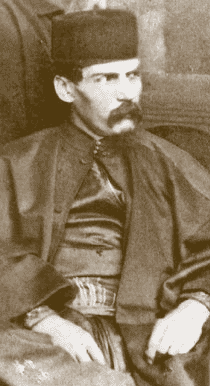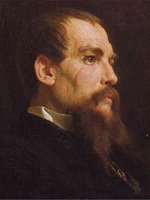 Years ago I read through Philip José Farmer‘s Riverworld books. Those of you who have read them will recall that Richard Burton
Years ago I read through Philip José Farmer‘s Riverworld books. Those of you who have read them will recall that Richard Burton
One of the indirect results of my doing that reading was that I was driven to find a copy of Burton‘s “Kasîdah“, or to use the full title “The Kasîdah of Hâjî Abdû El-Yezdî“. The work is referenced directly a couple of times in the Riverworld books, and is referenced thematically almost constantly. Also the titles of two of the books
As I found out more about The Kasîdah, the (true!) story behind it
Even more fascinating, though, was the content of the work. It’s a kind of Sufi text, and it’s also pretty much the only place where Burton wrote directly about his own beliefs (perhaps the shield of anonymity that his ‘merely the translator’ ruse gave him made it easier to be so direct).
 Traditionally a kasîdah is an Arabic or Persian panegyric. There is a definite three part thematic structure (nostalgia/journey/message) and a requirement for the same meter and rhyme scheme has to run through the entire composition, no matter how long the poem is. There’s some nice details on the tripartite structure in the Wikipedia entry for the form. Burton honours this form, but his instantiation of it might shock some of those 9th century Islamic scholars–it contains many references to 19th Century scientific and philosophical concepts, most notably the evolution of species. He introduces these as part of the metaphorical journey of the poem–a journey that starts as an individual one journeying from blind belief towards a very rational kind of Light, and which may be interpreted as “the philosophical and evolutionary journey of the vast caravan of humanity, from its forgotten origins to its unknown destination”
Traditionally a kasîdah is an Arabic or Persian panegyric. There is a definite three part thematic structure (nostalgia/journey/message) and a requirement for the same meter and rhyme scheme has to run through the entire composition, no matter how long the poem is. There’s some nice details on the tripartite structure in the Wikipedia entry for the form. Burton honours this form, but his instantiation of it might shock some of those 9th century Islamic scholars–it contains many references to 19th Century scientific and philosophical concepts, most notably the evolution of species. He introduces these as part of the metaphorical journey of the poem–a journey that starts as an individual one journeying from blind belief towards a very rational kind of Light, and which may be interpreted as “the philosophical and evolutionary journey of the vast caravan of humanity, from its forgotten origins to its unknown destination”
A recent post on Will’s blog got me thinking about the Kasîdah again, which lead to this post.
I’m not going to reproduce the whole thing here, but I can point you to a couple of different places where you can read it online, and maybe pull out a few quick selections from the text (which are nice, but even better in context).
I should also point out that there is a lovely bound edition still in print–I got a copy of this at the time I first got interested, since the work wasn’t available online at the time. It’s kept in print by a Sufi organization, and I love the idea of this book as an equivalent to the Gideon’s Bible.
The Kasîdah can be found online in many places now. One example is at the library of Adelaide University in Australia. I quite like page layout of that one for online read. An alternate example is the copy at ScaredTexts.com, which does a better job of maintaining the accents.
And here are a few selections, pulled from the Adelaide version:
Friends of my youth, a last adieu!
haply some day we meet again;
Yet ne’er the self-same men shall meet;
the years shall make us other men:
I am always a sucker for the “same man, same river” thing.
How Thought is imp’otent to divine
the secret which the gods defend,
The Why of birth and life and death,
that Isis-veil no hand may rend.Eternal Morrows make our Day;
our Is is aye to be till when
Night closes in; ’tis all a dream,
and yet we die,—and then and THEN?
This framing of one of the questions that the work deals with reminds me strongly of some passages in Santaya‘s Lucifer: A Theological Tragedy
There is no Good, there is no Bad;
these be the whims of mortal will:
What works me weal that call I ‘good,’
what harms and hurts I hold as ‘ill:’They change with place, they shift with race;
and, in the veriest span of Time,
Each Vice has worn a Virtue’s crown;
all Good was banned as Sin or Crime:
This is a remarkably broad view for someone from the society Burton was raised in. It’s pretty easy to imagine that his travels, adventures, and other experiences broadened his mind mightily and forced him to reexamine the unspoken dogma of his society though.
All Faith is false, all Faith is true:
Truth is the shattered mirror strown
In myriad bits; while each believes
his little bit the whole to own.What is the Truth? was askt of yore.
Reply all object Truth is one
As twain of halves aye makes a whole;
the moral Truth for all is none.
Now you start to see why reading this work would make a woman of Burton‘s time cry, as his wife is reported to have done in despair at her husband’s expressed beliefs.
There is no Heav’en, there is no Hell;
these be the dreams of baby minds;
Tools of the wily Fetisheer,
to ’fright the fools his cunning blinds.Learn from the mighty Spi’rits of old
to set thy foot on Heav’en and Hell;
In Life to find thy hell and heav’en
as thou abuse or use it well.
I am also quite happy with the notion that we make our own Heaven or Hell here on earth. You can see though how this could have put Burton at odds with his society–especially since he’s not shying away from some very aggressive phrasings. “Dreams of baby minds”. Yeah.
With Ignor’ance wage eternal war,
to know thy self forever strain,
Thine ignorance of thine ignorance is
thy fiercest foe, thy deadliest bane;That blunts thy sense, and dulls thy taste;
that deafs thine ears, and blinds thine eyes;
Creates the thing that never was,
the Thing that ever is defies.
“Thine ignorance of thine ignorance is / thy fiercest foe, thy deadliest bane” is perhaps my favourite line in the work. It’s a very classical idea of course
These a just glimpses into the work, and I assure you that spending a little time with the whole thing will be rewarding. Also, if you read the Riverworld books afterwards, it’s almost an entirely different experience.


4 comments for “The Kasîdah of Hâjî Abdû El-Yezdî”